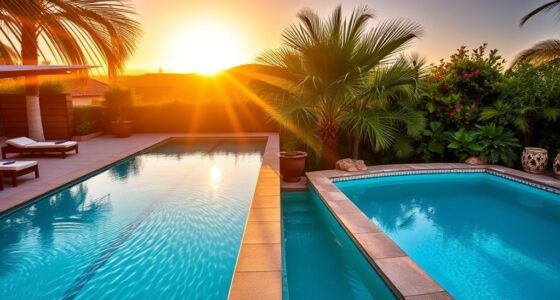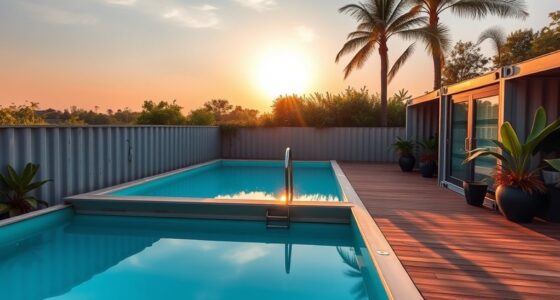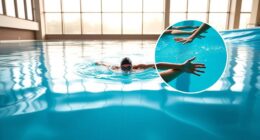Yes, you can build your own lazy river, but it’s an ambitious project that requires careful planning and a good understanding of construction and maintenance. You’ll need to contemplate design, jet technology for water flow, and landscape integration to enhance the overall experience. Be prepared for significant costs, both upfront and ongoing for maintenance. You might want to explore more tips and insights that’ll help you create the perfect lazy river for your backyard oasis.
Key Takeaways
- Building a DIY lazy river is complex and may exceed standard pool prices due to custom designs and infrastructure needs.
- Proper planning for water flow, filtration, and jet technology is essential for effective movement and maintenance.
- Regular maintenance and monitoring of water levels and chemical balance are crucial for a successful DIY project.
- Landscaping and aesthetic considerations enhance the experience, requiring careful selection of plants and features.
- Consulting professionals can help ensure safety, compliance, and optimal design for a DIY lazy river project.
The Lazy Design Phase

When you’re designing a lazy river, it’s not just about sketching a simple rectangle; you need to think carefully about curves, features, and the overall flow of the water.
To create a lazy river that truly stands out, focus on custom lazy river designs that enhance user experience. Consider how the water will move, incorporating gentle bends and exciting features like waterfalls or bridges. A well-designed lazy river can also encourage physical activity for users, promoting a healthier lifestyle. Furthermore, utilizing smart shopping strategies can help you source high-quality materials at unbeatable prices.
Don’t forget to plan for necessary infrastructure, like filters and drains, ensuring both functionality and aesthetics. Concrete is essential for creating durable water-holding sections and landscaping elements.
Without thoughtful planning, you risk ending up with barren concrete areas that detract from your lazy river pool’s enjoyment. Prioritize a unique layout to make your project a relaxing oasis. Additionally, incorporating greenhouse benefits can enhance the overall ambiance and usability of your lazy river area.
Do You Like Your Friends and Family?

Creating a lazy river can be a fantastic way to unwind, but it also raises questions about how it fits into your social life.
While you might envision a Family Haven filled with laughter and relaxation, the reality can be quite different. A lazy river often promotes a more isolated experience, as the design encourages individual floating rather than group interaction.
Conversations can be challenging with the current pulling you along. Family gatherings around a lazy river may lack the engaging activities that a traditional pool offers.
With a shallow depth of 2 to 4 feet, diving and other fun water games aren’t possible either. If you truly enjoy spending time with friends and family, consider how a lazy river aligns with your social goals. Additionally, many hotels with water parks offer more interactive experiences that cater to group activities and fun.
Jet Technology
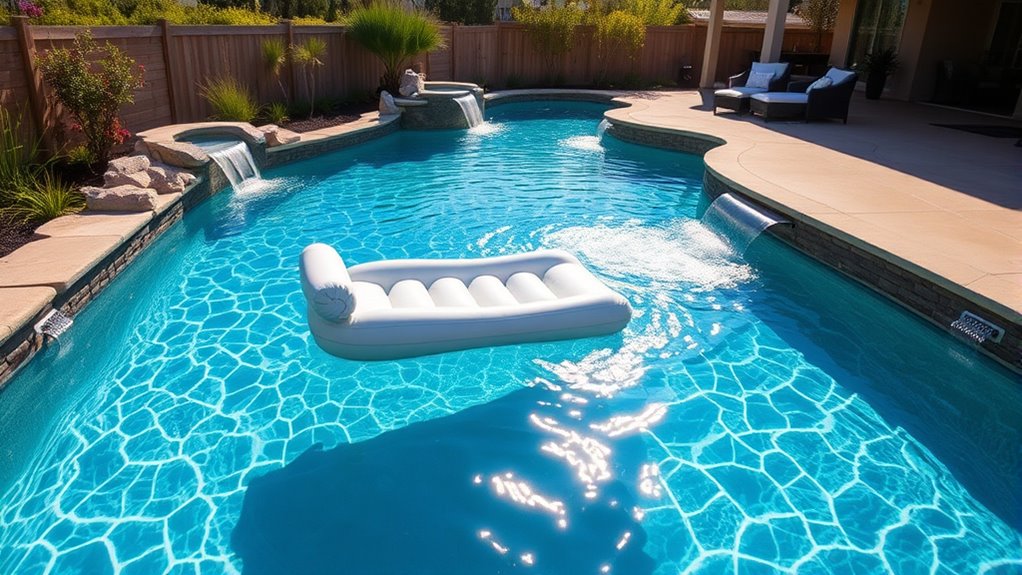
To enjoy a truly relaxing experience in your DIY lazy river, understanding jet technology is important. This technology is essential for creating an effective current, requiring multiple powerful pumps to guarantee sufficient water movement.
You’ll need to install jets with skill, as improper placement can hinder your river’s functionality. Each jet must be strategically positioned to create a smooth, continuous flow that enhances your lazy river experience.
Consider integrating a Fastlane Pro system, which can help optimize water flow and pressure. Regular maintenance of your jet system is critical, as consistent performance relies on proper management.
A well-designed jet system not only boosts the current but also enhances the overall aesthetics and functionality of your pool environment.
You Lack Depth
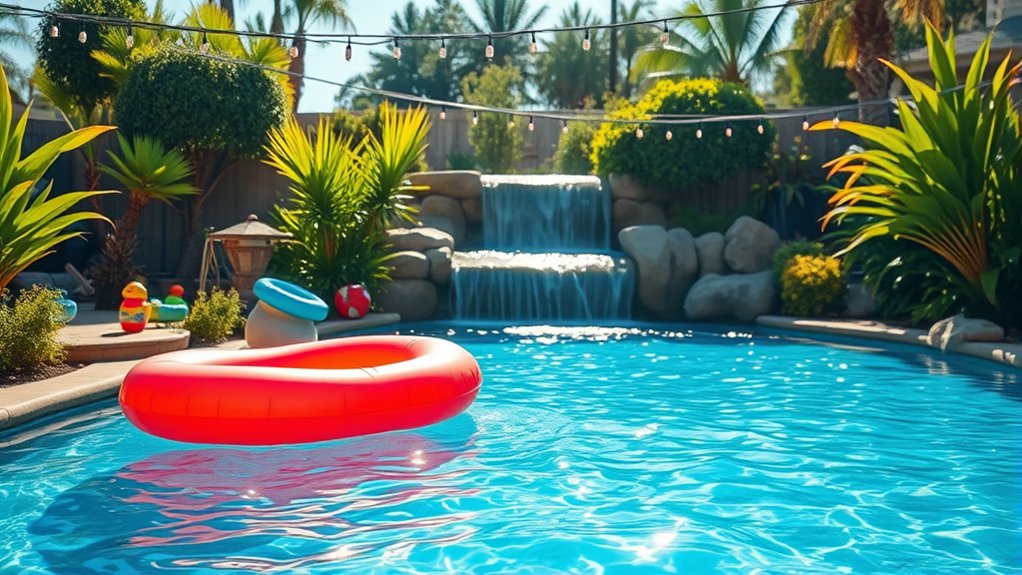
When you create a lazy river, you might find that its shallow depth limits your options for fun.
While floating and leisurely swimming are enjoyable, you won’t be able to do things like underwater exercises or lap swimming.
This lack of depth can make your pool experience feel a bit one-dimensional, especially for kids looking for more adventurous features.
Limited Activity Options
While lazy rivers offer a relaxing escape, their shallow depths—typically between 2 to 4 feet—limit your options for engaging activities. The limited depth restricts underwater workouts, lap swimming, and diving, making it difficult to enjoy more active pursuits. Children might miss out on traditional features like diving boards and slides, further reducing the fun.
| Activity | Possible? | Reason |
|---|---|---|
| Underwater Workouts | No | Limited depth |
| Lap Swimming | No | Shallow waters |
| Diving | No | Not enough depth |
Ultimately, lazy rivers primarily promote floating and leisure, which may not satisfy everyone’s activity options. If you crave more engagement, consider alternative setups.
Shallow Water Challenges
Even though lazy rivers provide a soothing retreat, their shallow depths present significant challenges for anyone seeking more dynamic water activities.
With depths typically ranging from 2 to 4 feet, you’ll find these limitations:
- Limited options for underwater workouts or lap swimming.
- Kids miss out on diving boards and slides.
- The shallow depth mainly accommodates floating, not active play.
- Reduced engagement can diminish social interactions.
- Less versatility compared to deeper pools.
While a lazy river is perfect for relaxation, the lack of depth can leave you craving more stimulating experiences.
If you’re after versatility and active fun, consider how these shallow water challenges may impact your DIY project.
Extraordinary Pool Comes With Extraordinary Costs

Creating a lazy river pool can be an enticing dream, but it comes with a hefty price tag that many homeowners mightn’t be prepared for.
Custom lazy rivers can range from $120,000 to over $500,000, depending on the design and materials. Even DIY projects can become costly due to their complexity, often exceeding standard pool prices.
Additionally, you must factor in maintenance costs, which can reach $500 or more each month. These extraordinary costs can strain your budget, making it essential to assess your financial situation before diving in.
If budget constraints are significant, you may want to reconsider the feasibility of installing a lazy river in your backyard paradise.
Covering and Maintenance

Maintaining your DIY lazy river requires consistent effort to keep it in excellent condition. A well-chosen cover can greatly reduce your maintenance time by protecting the water from debris.
Regular monitoring of the water level is essential, as evaporation can impact flow. Here’s what you should focus on:
- Clean the water surface regularly to avoid debris buildup.
- Manage chemical levels to guarantee water quality.
- Check pump and jet systems for peak functionality.
- Perform seasonal maintenance by draining for thorough cleaning.
- Consider hiring a professional service for complex issues.
Creating Your Own Lazy River

When you’re ready to create your own lazy river, careful planning and design are key to success.
You’ll need to contemplate the layout, water flow, and essential equipment to make it a reality.
With the right approach, you can transform your backyard into a relaxing oasis.
Planning and Design Tips
To design a DIY lazy river that flows seamlessly through your backyard, you’ll want to carefully plan its layout and how it integrates with any existing pool features.
Keep these tips in mind for a successful project:
- Consider the flow: Make sure the river winds smoothly for a relaxing experience.
- Choose the right pumps: Opt for larger, powerful pumps to maintain a consistent current.
- Budget wisely: Costs can range considerably, so plan your finances accordingly.
- Focus on landscaping: Incorporate lush greenery and decorative elements to enhance aesthetics.
- Consult professionals: Their expertise can help with functionality, safety, and compliance with local regulations.
With proper planning, you can create a stunning lazy river that adds enjoyment to your backyard.
Essential Equipment Needed
Creating a DIY lazy river requires specific equipment to guarantee an enjoyable and efficient experience.
You’ll need powerful pumps, ideally with a combined output of at least 5,000 gallons per minute, to keep the water flowing smoothly. Incorporating Fastlane jet systems is essential, as multiple high-capacity jets create the consistent current necessary for a true lazy river vibe.
A robust filtration system is vital to maintain water quality, especially since lazy rivers have larger volumes than standard pools and require frequent filtration.
For construction, use concrete or other durable materials for the walls and bottom of the river.
Don’t forget to enhance the environment with landscaping elements like plants, rocks, and water features to create a welcoming atmosphere around your DIY lazy river.
Complementing Your Pool With Your Lazy River

A well-designed lazy river can transform your backyard into a serene oasis, perfectly complementing your existing pool.
Transform your backyard into a serene oasis with a well-designed lazy river that complements your existing pool.
To guarantee a cohesive design, consider these key elements:
- Size and Shape: Choose dimensions that align with your pool for a seamless look.
- Water Flow: Consult with professionals to optimize flow using a Fastlane Pro current system.
- Access Points: Strategically place entry and exit points for easy movement and safety.
- Visual Appeal: Integrate design elements that enhance both the lazy river and pool aesthetics.
- Functionality: Ensure the lazy river adds to the overall experience, making your backyard a relaxing retreat.
With careful planning, your lazy river can enhance your outdoor space beautifully.
Landscaping for Your Lazy River
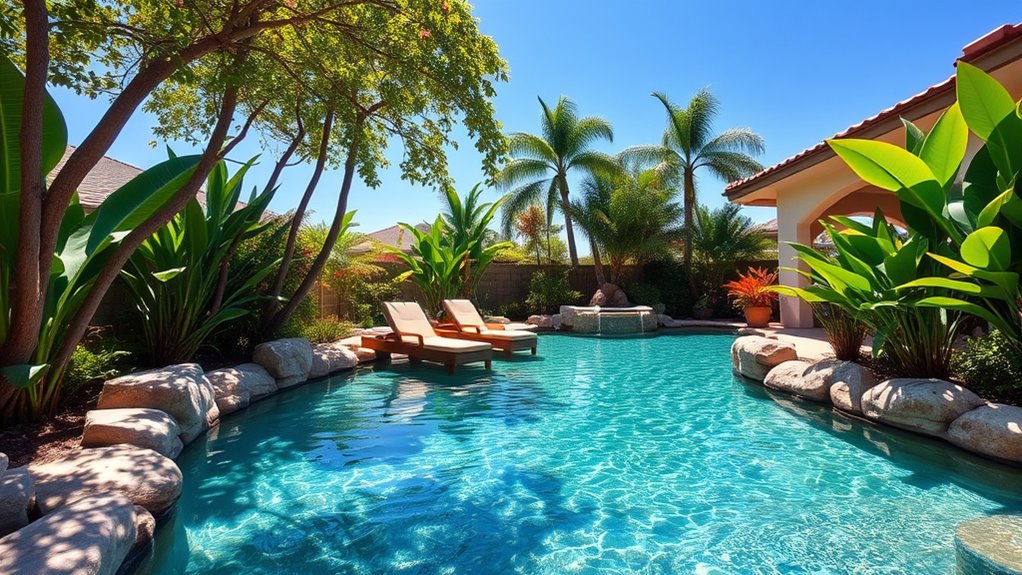
While you’re designing your lazy river, don’t underestimate the impact of landscaping in shaping an inviting atmosphere.
Thoughtful landscaping enhances both the aesthetic appeal and enjoyment of your space. Incorporating a variety of plants, like palm trees and flowering shrubs, creates a lush, tropical vibe that draws you in. If you’re uncertain about plant choices, consider getting professional help to guarantee the selections suit your climate and complement your design.
For larger lazy rivers, add decorative rocks, pathways, and seating areas to enrich the experience. You might also integrate features like waterfalls and grottos, which beautify your lazy river while contributing to a relaxing ambiance.
With the right landscaping, you’ll elevate your oasis to new heights.
Frequently Asked Questions
Can You Make Your Own Lazy River?
You can definitely make your own lazy river, but it’s not a simple task.
You’ll need to plan for water flow, filtration, and landscaping to avoid dull areas. Costs can add up quickly, often exceeding standard pool prices.
You might need multiple pumps to create the current, and it’s wise to seek professional help for site prep and local regulations.
Don’t forget about ongoing maintenance that can hit your budget monthly!
How Much Does It Cost to Build Your Own Lazy River?
Building your own lazy river can cost you anywhere from $50,000 to over $500,000, depending on size and design.
Even basic DIY projects might set you back over $30,000. Don’t forget about monthly maintenance, which can reach $500 or more.
You’ll also need to budget for permits and site prep, as well as any custom features like waterfalls or slides, which can really add to the overall price.
Careful planning is key!
Is It Possible to Build Your Own Swimming Pool?
Building your own swimming pool is like crafting your own oasis in the backyard. Yes, it’s possible, but it’s no walk in the park.
You’ll need to plan meticulously, gather materials, and navigate local permits. While you might save some cash, don’t forget to factor in ongoing costs for maintenance.
If you’re ready for the challenge, just make sure you’ve got the skills to avoid costly mistakes that could sink your dreams.
What Do You Need for a Lazy River?
To create a lazy river, you’ll need ample space, ideally at least 500 square feet.
Gather essential materials like concrete for the riverbed and walls, plus high-powered pumps to generate the current.
Don’t forget a reliable filtration system to keep the water clean, along with landscaping elements like plants and rocks for added charm.
It’s wise to seek professional help for design and installation to guarantee everything flows smoothly and meets local regulations.
Conclusion
Building your own lazy river can be like crafting a dreamscape where relaxation flows as freely as the water. With careful planning and a sprinkle of creativity, you can transform your backyard into a serene oasis, inviting friends and family to drift alongside you. Just remember, while the journey may have its bumps, the joy of floating through your own creation is worth every ripple. So plunge in and let the good times roll!


